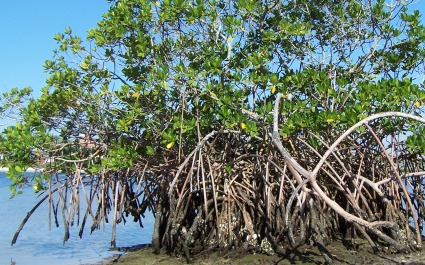Long before so many American jobs were outsourced, our food supply network was spread across the globe. Over a hundred years ago, the great short story writer O.Henry located many of his tales in Central America on fruit plantations or the ships that brought the fruit to the U.S. It was not a pretty picture then, and it’s worse now.
Most of the shrimp consumed in the U.S. now comes from southeast Asia, where factory fish farms are set up along the coast, destroying mangrove forests in the process. Mangroves are those weird-looking trees with roots above the water line, but to people who used to live there, they were home. And to children at the Avocado Elementary School, they were a wonderful home to wildlife (see their wonderful illustration).
But fish farms are just as destructive as factory farms on land. Result: the carbon footprint of these shrimp is higher than that of beef from ranches built on land that was once Amazon rainforest. Tom Philpott, a great food writer for Mother Jones, quoted this bleak conclusion from the book Bottomfeeder by Taras Grescoe: “The simple fact is, if you’re eating cheap shrimp today, it almost certainly comes from a turbid, pesticide- and antibiotic-filled, virus-laden pond in the tropical climes of one of the world’s poorest nations.”
So to get your food choices out of all this destruction, please take shrimp off your menu, if you haven’t already. Delicious options that are easy on the earth and kind to your conscience can be found at Bay Area restaurants such as Café Gratitude in San Francisco, Lydia’s Kitchen Cafe in Fairfax, and International Vegetarian House Restaurant in San Jose.

